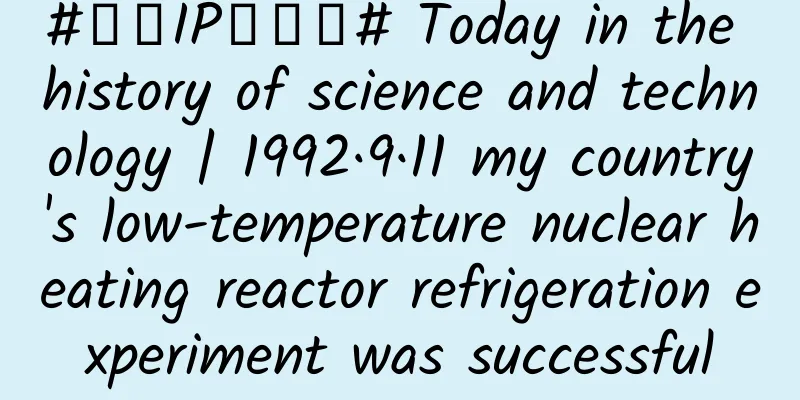#千万IP创科普# Today in the history of science and technology | 1992·9·11 my country's low-temperature nuclear heating reactor refrigeration experiment was successful

|
On September 11, 1992, the refrigeration experiment of the low-temperature nuclear heating reactor, a key national scientific and technological project during the "Eighth Five-Year Plan", was successfully completed. The project filled the gap in my country's new nuclear energy refrigeration and air-conditioning technology, and realized the use of nuclear energy for cooling in summer, heating in winter, and combined heat and power, with one reactor for multiple uses, opening up a new path for the comprehensive utilization of nuclear energy. ●New ways to use nuclear energy As we all know, nuclear energy can not only generate electricity, but also provide heat. Nuclear power plants use the heat generated by nuclear reactors to turn water into steam to drive steam turbines to generate electricity. The condenser of the steam turbine unit takes away the residual heat of the steam that has generated electricity. Therefore, even for large nuclear power plants, their thermal efficiency is not high, only more than 30%, and more than 60% of the energy generated by the reactor is not used. In this situation, researchers began to study the method of combined heat and power, using the hot water discharged from nuclear power plants for heating, seawater desalination, etc., so that the thermal efficiency of nuclear reactors can be increased to more than 50%. However, in combined heat and power, heating is only a form of waste heat utilization and cannot meet the requirements of large-scale heating, so scientists have specially designed nuclear reactors for heating. Nuclear energy heating can be divided into high-temperature nuclear heating, medium-temperature nuclear heating and low-temperature nuclear heating according to the heating temperature. The heat source provided by high-temperature nuclear heating reactors has a high temperature, generally above 300°C, and even as high as 1000°C. It is mainly used for industrial heating such as smelting and chemical industry. The heating temperature of medium-temperature nuclear heating reactors is between 150℃ and 300℃, and they are mainly used in the textile, papermaking, pharmaceutical and other industrial sectors. However, there are many technical problems in using nuclear energy for heating in this temperature range, and it is not economically viable. Therefore, medium-temperature nuclear heating reactors cannot be widely used in the short term. The heating temperature of low-temperature nuclear heating reactors is below 150℃. From the current actual situation, whether in industrial production or daily life, this temperature range has the largest number of users and the largest amount of consumption, accounting for about half of the total heat consumption. Therefore, its development prospects are very attractive and it has become a leader among nuclear heating reactors. ● Became a world leader in nuclear heating As early as 1964, a group of young teachers and students at Tsinghua University, with an average age of only 23 and a half, developed the first shielded test reactor in my country's universities with the spirit of self-reliance, hard work, daring to think and act, and fearlessness of sacrifice. In 1981, Tsinghua Nuclear Research Institute, led by nuclear energy scientist Academician Wang Dazhong, began to conduct research on low-temperature nuclear heating, and successfully conducted the first domestic reactor residual heat heating operation test in the winter of 1983. At the end of 1983, the institute carried out technical transformation of the shielded test reactor and conducted my country's first low-temperature nuclear heating test, successfully heating three buildings with a total area of 15,000 square meters and obtaining important data on safety and operating characteristics. In 1984, the then State Science and Technology Commission approved the construction of a 5-megawatt nuclear heating test reactor at Tsinghua Nuclear Energy Institute. Since 1986, low-temperature nuclear heating has been officially listed as a national scientific and technological project, and the Tsinghua Nuclear Energy Institute has been responsible for the comprehensive development of low-temperature nuclear heating reactors. In March 1986, the construction of a 5-megawatt low-temperature nuclear heating reactor officially started next to the shielded test reactor at Base 200. On November 11, 1989, the 5MW low-temperature nuclear heating reactor was officially started up. On December 19, it successfully completed a 72-hour full-power continuous operation test. Subsequently, the 5MW low-temperature nuclear heating reactor achieved successful combined heat and power operation in September 1991. On September 11, 1992, the experiment of the refrigeration system of the low-temperature nuclear heating reactor, a key scientific and technological project of my country, was successful. This system adopts the currently advanced lithium bromide absorption refrigeration technology in the world, takes the low-temperature heating reactor as the heat source, and replaces electricity and oil-fired coal to achieve large-scale air conditioning and refrigeration. In the summer, when the temperature is above 30℃, the indoor temperature can be maintained at around 20℃. At the same time, it can use the existing heating pipes, without the need for additional pipe network construction costs, and realizes the use of nuclear energy for heating in winter and cooling in summer, opening up a new way for the comprehensive utilization of nuclear energy heating. The reactor is the world's first integrated natural circulation shell heating reactor put into operation, and it is also the world's first reactor using a new type of hydraulically driven control rod. Its successful operation has enabled my country to enter the ranks of the world's advanced countries in the field of low-temperature nuclear heating. ●Broad development prospects in the future In my country, more than half of the cities are in the "Three Norths" (Northeast, North China, and Northwest China). As the urban construction area in these regions increases, the heat source for heating and heat supply must also be increased. In recent years, the construction of northern cities has grown at an astonishing rate. In the early 1990s alone, the urban construction area increased by 1.3 billion square meters, and the heating capacity needs to be increased by at least 50 million kilowatts. This will increase coal consumption by more than 50 million tons each year. In the long run, heating energy will be a very large number. my country's urban heating energy mainly relies on coal, which not only wastes coal, a precious chemical raw material, but also concentrates pollutants emitted by burning coal in urban areas, resulting in a very bad urban environment. Beijing, Xi'an and Shenyang have been listed as among the most polluted cities in the world. If heating is still mainly based on coal burning under the condition of rapid growth of urban construction in the future, the environmental pollution caused will reach an unbearable level. However, based on my country's current nuclear fuel production capacity and relatively mature nuclear reactor technology, the development and construction of low-temperature and low-pressure nuclear heating reactors is a feasible way in accordance with my country's national conditions and economically and technically. Experts say that the radioactive emissions of low-temperature nuclear heating reactors are very small. Taking the 5-megawatt low-temperature nuclear heating reactor of Tsinghua University as an example, the harm to the human body caused by the radioactivity it emits into the atmosphere is only equivalent to the damage caused to the body by smoking one cigarette in a year. Because it adopts advanced technologies such as integration, self-stabilization, full-power natural circulation, new control rod hydraulic transmission, passive residual heat removal, and double pressure shell, it has inherent safety and can be built near cities. Low-temperature nuclear heating reactors have good economic, social and environmental benefits, and are a safe, clean and economical large-scale heat source. In the future, low-temperature nuclear heating reactors can not only replace coal with nuclear power, reduce transportation pressure and improve the urban environment, but also provide low-pressure industrial gas to industrial and mining enterprises, carry out low-temperature nuclear power generation and low-temperature nuclear refrigeration, and have broad development prospects in many aspects such as seawater desalination and radiation processing. Comprehensive from "Scientific Inquiry", People's Daily Online |
<<: Where is the quietest Guangdong?
>>: The "anti-aging timetable" is here! People who often do this will really be younger
Recommend
Can't resist the "sweet temptation"? Why not give it to "red, orange and green"?
This is the 4582nd article of Da Yi Xiao Hu News ...
Aiti Tribe Stories (7): Meet 51CTO and aim high
[51CTO.com original article] The protagonist of t...
Elderly care robots are here! They can make tea, feed cats, practice Wing Chun, play the piano, flip the spoon and play mahjong
Author Li Chuanfu Elderly care robots are here! S...
Why do our fingers or toes get wrinkled after being in water for a while?
If the hairless skin on a person's fingers, t...
"Ice falling" incidents are entering a high incidence period! Remember these "ice" mitigation strategies to save your life at critical moments →
At present, as the temperature drops, many rivers...
No idea for event operation? Maybe you should read this article...
As an employee of the company, it is more accurat...
For community operation, you need to build a good “personality”!
In community operations , building a good persona...
What are machine learning and deep learning? Faizan Shaikh will help you answer
Abstract: This article introduces the definitions...
Belief is priceless! The long-delayed ASUS ROG Claymore RGB mechanical keyboard is still worth buying
God said, "Let there be light," and the...
1.5 million UVs in 3 hours! How powerful is NetEase’s childhood H5 that has been all over the screen?
How many times has your circle of friends been fl...
How to do offline community marketing?
With the vigorous development of China's soci...
Say goodbye to confusion and become an operator with "routines"
Having been engaged in product operations for man...
New ways of playing for top private domain brands
Nowadays, many companies are using private domain...
Xiaohongshu Promotion Content Operation Strategy
I have to say that the speed of development of th...
Why do banks love to build big buildings? Are there billions of dollars hidden inside?
One minute with the doctor, the postures are cons...









